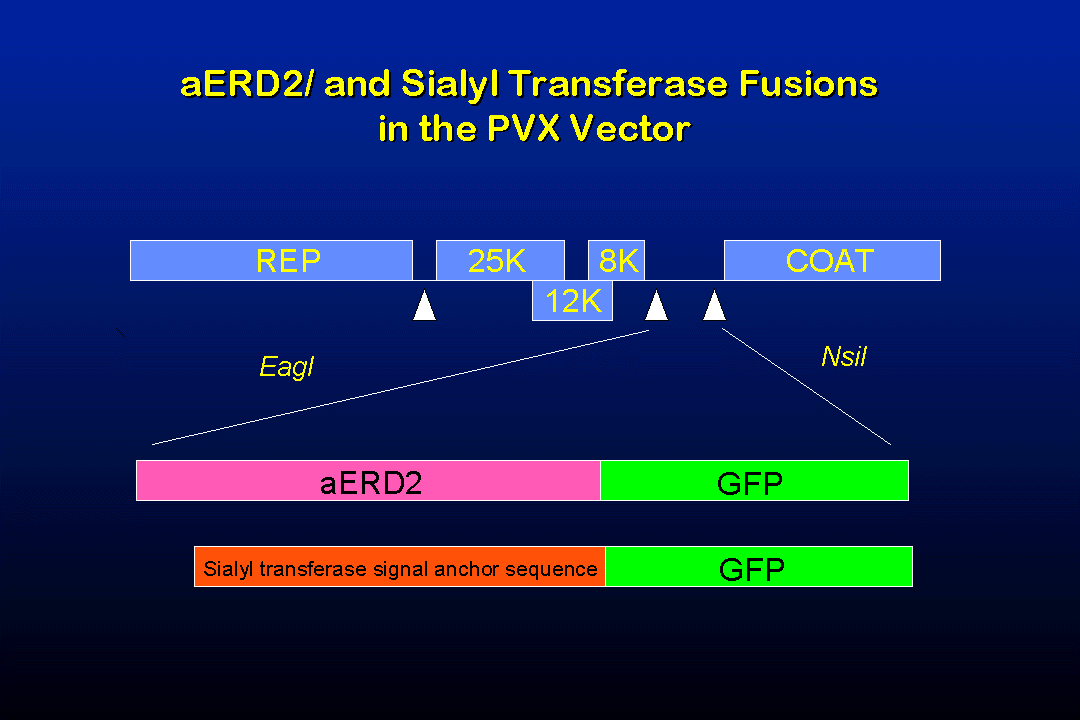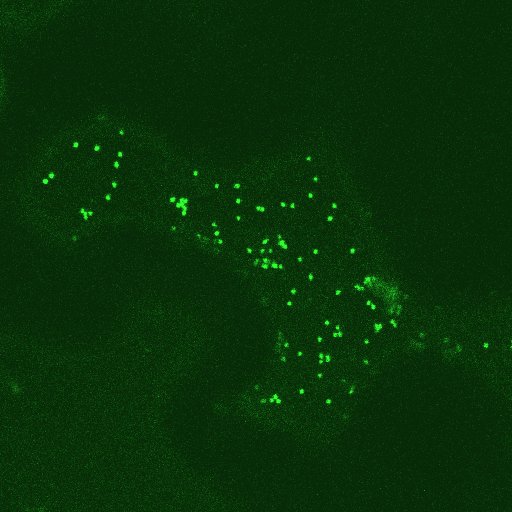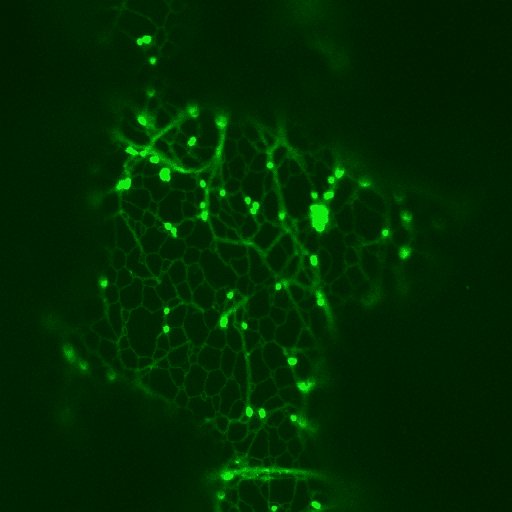Original URL:
http://www.brookes.ac.uk/schools/bms/research/molcell/hawes/gfp/gfp.html
STACKS ON TRACKS
- Targeting GFP to the Plant Golgi Apparatus
Chris
Hawes & Alan Betteridge,Research School of Biological &
Molecular Sciences,Oxford Brookes University, Oxford, OX3 0BP, UK
Petra Boevink, Simon Santa Cruz &
Karl Oparka, Scottish Crop Research Institute, Dundee,UK.
Introduction:
 |
In order to further our understanding of the distribution and dynamics of
the individual cisternal stacks comprising the Golgi apparatus in plant cells,
we have spliced the jelly fish green fluorescent protein (GFP) to two proteins
that would be predicted to be targeted to Golgi membranes. These fusions were
expressed in leaves of Nicotiana clevlandii using the potato virus X
expression system1. Firstly, GFP was fused to the C-terminus of the
trans-membrane domain (TMD) of a rat sialyl transferase which would be predicted
(in mammalian cells) to target to the trans-region of the Golgi stack.
Secondly, GFP was spliced to the C-terminus of the Arabidopsis homologue
of the yeast HDEL receptor, aERD2. This protein acts as a receptor, returning
any escaped luminal ER processing proteins from the cis- Golgi back to
the ER. |
|
It would therefore be predicted to reside predominantly in the Golgi and
cycle to and from the ER. Segments of infected leaves were observed by confocal
microscopy and movies made using Zeiss time resolved software. The relationship
between the Golgi apparatus, ER and the cytoskeleton was observed in aERD2-GFP
expressing leaf cells after paraformaldehyde fixation, permeabilisation and
staining with rhodamine conjugated phalloidin. |
Results:
Leaf cells expressing the TMD-GFP fusion exhibited a population of highly
fluorescent mobile organelles located in the cortical cytoplasm of epidermal
cells, the dynamics of which can be viewed in a movie.
Movie showing targeting of sialyl-transferase
signal-anchor sequence to Golgi (avi file)

Expression of rat sialyl transferase signal
anchor sequence-GFP in leaf epidermal cells |
Immunogold electron microscopy with an anti-GFP serum (Molecular Probes)
showed the construct to be predominantly located towards the trans-face of the
Golgi stacks. This result indicate that the mechanism employed by mammalian
cells for locating Golgi transferases also functions in plant cells, suggesting
the evolution of a pan kingdom targeting strategy for such processing enzymes.
Epidermal leaf cells expressing the aERD2-GFP protein again exhibited a
population of highly flourescent mobile organelles, but also a cortical
reticular network of ER extending into trans-vacuolar strands. |

Expression of aERD2-GFP in a leaf
epidermal cell |
We have previously described this cortical ER network which can be revealed
by GFP-HDEL fusions. Immuno-electron microscopy showed the location of the
ERD2-GFP protein was also in the Golgi stacks which as in the TMD-GFP fusion
were again highly mobile but now could be observed to be exclusively assocated
with the ER and travelled along the cortical ribbons of ER membrane whilst
occasionally jumping onto rapidly streaming strands of ER. This movement of
Golgi is both uni- and bi-directional along a strand of ER and often saltatory
for several seconds before accelerating down a strand. This novel close
association of Golgi and ER can be viewed in the movies- showing tracking of
Golgi on cortical ER. aERD2-GFP fusion. Movie 1 (avi file)
Movie
2 (avi file)
|

Epidermal cell cortical actin network (red)
in a cell expressing aERD2-GFP.
By reducing the green signal and removing
ER fluorescence the Golgi can be seen aligned
on actin cables |
Rhodamine phalloidin staining of the epidermal cells revealed a cortical
network of actin filaments which were overlaid by the cortical ER network. By
reducing the contrast of the ER in green image of these double labelled
preparations it could be seen that the Golgi bodies were also associated with
this actin network. |
References:
1Oparka, K.J., Boevink, P. and Santa Cruz, S. (1996). Studying the movement
of plant viruses using green-fluorescent protein. Trends in Plant Sci.
1, 412-418.
2 Boevink, P., Santa Cruz, S., Hawes, C., Harris, N. and Oparka, K.J.
(1996). Virus-mediated delivery of the green fluorescent protein to the
endoplasmic reticulum of plant cells. The Plant Journal 10,
935-941.
For further details contact: Dr Chris
Hawes, Research School of Biological & Molecular Sciences,Oxford Brookes
University, Oxford, OX3 0BP, UK
Other Research in
Molecular and Cell Biology
|
Botanik online - Botany online
|
Peter v. Sengbusch - b-online@botanik.uni-hamburg.de



